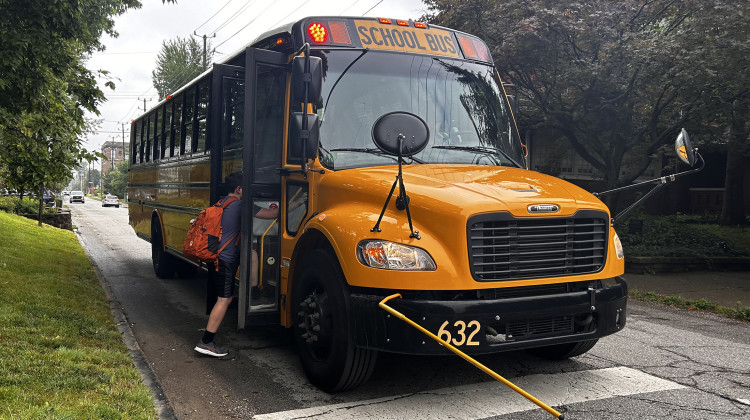
Students, parents and educators in the Indianapolis Public Schools district provide public comments on the district’s proposed overhaul plan before the school board votes on the plan in two weeks.
Elizabeth Gabriel/WFYIFor the first time, the Indianapolis Public Schools district has announced how it will pay for its expansive plan to close and merge six schools and change grade configurations at nearly three dozen schools. The plan, which has been unpopular among many community members, requires voters to approve over $800 million in property tax referendums in the May 2023 election.
IPS also announced minor changes to the Rebuilding Stronger initiative – its plan to overhaul the district to simultaneously improve academic performance for students of color.
The final plan, like the draft released last month, would close and consolidate schools, duplicate popular academic programs, upgrade and construct new buildings, and create standalone middle schools. It would also establish enrollment zones so all neighborhoods would have similar access to different choice schools.
“Our community has supported us in the past, and [I hope] they will continue to support us because of what it means for the experiences our kids can have, and the opportunity to continue to support our teachers and doing the work that they do everyday,” Superintendent Aleesia Johnson said to WFYI ahead of the Thursday board meeting, when plan updates were shared with the community.
IPS could ask voters to approve $810 million in referendums
Much of the plan relies on voters approving a new $410 million capital referendum. The funds would cover the costs of facility updates, which include improvements to building security and athletic fields, among other projects at 14 buildings. Fifteen of 67 IPS school buildings are in poor or worse condition, according to district documents.
IPS would also ask voters to approve an eight-year operating property tax referendum that would cost roughly $400 million, or $50 million annually. That would lead to a monthly property tax increase of approximately $6 for the average homeowner over the duration of the referendum. Johnson said those dollars would support staff compensation. Last year the district provided teachers with a 3 percent pay increase, making it one of the highest paying school districts in Marion County.
If approved, the new referendums would replace the current referendums voters approved in 2018 for $220 million in general spending and $52 million for capital projects. Since then, the district has reduced spending by $261 million, but that’s nearly $67 million less than projected. But Johnson said IPS, in partnership with the Indy Chamber, over projected how much money they would save by having some high schoolers use IndyGo transportation services.
Johnson said the referendums would allow the district to provide popular academic programming to all students in order to improve academic performance. But Johnson said the district would have to reevaluate its plan if the referendums aren’t approved.
”If what our community says is, ‘This is not something we support,’ then I fully anticipate we'd be engaging in a different process which will be much more about, well, what do we need to reduce and do away with,” she said.
If the capital projects referendum isn’t approved, it would take longer for the district to complete facilities improvements. This could also halt the continuation and expansion of certain programming. But the district plans to move forward with school closures if approved by the board of commissioners.
“I think that school closures, certainly that's not going to hang in the balance,” Johnson said. “I think after May [if the referendums don't pass], we would need to have a conversation about, you know, are there additional schools that may need to come off line or additional reductions that we need to make.”
IPS unveils news changes to Rebuilding Stronger plan
Over the past year, IPS staff have developed a plan to provide students with more due to poor conditions and low enrollment. Thursday the district announced additional facilities updates to some schools, as well as the following new school programming updates:
- William Penn School 49 will still become a middle school, but IPS will run School 49 with a STEM model rather than continue an Innovation partnership with Cold Spring. Cold Spring will stay a K-8 school for the duration of its Innovation agreement, through June 2027, and serve Zones 1 and 2.
- Center for Inquiry 2 and Washington Irving Elementary School 14 will no longer merge. Both schools will remain open and operational. IPS might partner with the Near Eastside Innovation School Corporation, or IPS will run the School 14.
- Edison School of the Arts and James Whitcomb Riley 43 will remain K-8 for the duration of their agreement through June 2027.
- There will be a cohort for the current 6th graders at Theodore Potter School 74 to go to Harshman Middle School to provide them with continued dual language immersion instruction.
The goal of the sweeping changes is to improve academic performance by providing more rigorous options for Black and Brown students who lag behind their White peers in the district and offer equitable access to special education services, athletics, extracurricular activities and academic programs no matter where a student lives in the city.
The district has a long road ahead to improve state standardized test scores to meet the board of commissioners’ goal of a 50 percent pass rate by 2025 for Black and Hispanic students. In 2022, only 5 percent of Black students and nearly 8 percent of Hispanic students passed both the English Language Arts and math portions of ILEARN. That’s compared to 35 percent of their White peers.
Now students in grade 6 or higher would have enrollment lottery priority for both the 2023-24 and 2024-25 school years. IPS will also assign schools for any students who don’t make a selection by the end of the second Enroll Indy deadline.
Proposed major changes from the original plan still in place
Currently, not all schools offer the same advanced courses due to staffing and resource constraints. Under the new model, all elementary and middle schools would have the same arts, music, physical education or computer science classes, as well as other programming.
The district will end the K-8 school model for district-run schools and establish K-5 elementary schools and 6-8 middle schools. Each zone will have access to a middle school that offers a specialized program – International Baccalaureate, STEM, arts or others. But in order to provide these offerings, the original and updated proposals suggest closing six schools, merging others and changing grade configurations at nearly three dozen schools.
IPS proposed the following new buildings:
- Construct two new elementary schools and make improvements at 14 facilities.
- Reopen the Thomas Carr Howe High school building to provide IB programming to middle schoolers.
- Purdue Polytechnic North High School would permanently remain in the Broad Ripple High School building.
The district will also create a middle school success advisory committee to help transition to grade 6-8 buildings.
IPS would also close schools with low enrollment, academic performance or unsafe building conditions. The following are the schools initially suggested for closure and consolidation at the end of this school year:
- George Buck School 94; Floro Torrence School 83; Raymond Brandes School 65; and Francis Bellamy Pre-School Center and Step Ahead Program will close.
- Francis Parker School 56 would close and merge with James Russell Lowell School 51. School 51 becomes a Montessori program.
- Paul Miller School 114 would close and merge with Frederick Douglass School 19. School 19 would no longer be operated as an innovation school.
IPS’ efforts to reach the community, parents’ reactions
IPS held more than 75 public meetings about the original proposed plan and provided language interpretation services. They also sent families automated text messages, voicemails and emails, and passed out informational packets in car lines, to students walking home and bus riders.
Students, parents and community members have voiced concerns about the plan at community meetings over the past month. The district’s teachers’ association also asked the district to push back its timeline for approving any changes. All four IPS school board candidates said they would vote against the original plan. Parents have provided feedback that they want more details and transparency about the plan, better teacher retention for educators at schools that are closing and have concerns about how to safely transport multiple kids if grade configurations change and force them to attend multiple school buildings.
What’s next?
The IPS board of commissioners is now scheduled to vote on the plan during their work session on Nov. 17. If approved, some schools would close at the end of this school year. New grade configurations would begin for the 2024-2025 school year. Facilities updates and construction for new buildings would start next school year and are expected to be completed during the 2026-2027 academic year.
Contact WFYI education reporter Elizabeth Gabriel at egabriel@wfyi.org. Follow on Twitter: @_elizabethgabs.
 DONATE
DONATE






 Support WFYI. We can't do it without you.
Support WFYI. We can't do it without you.